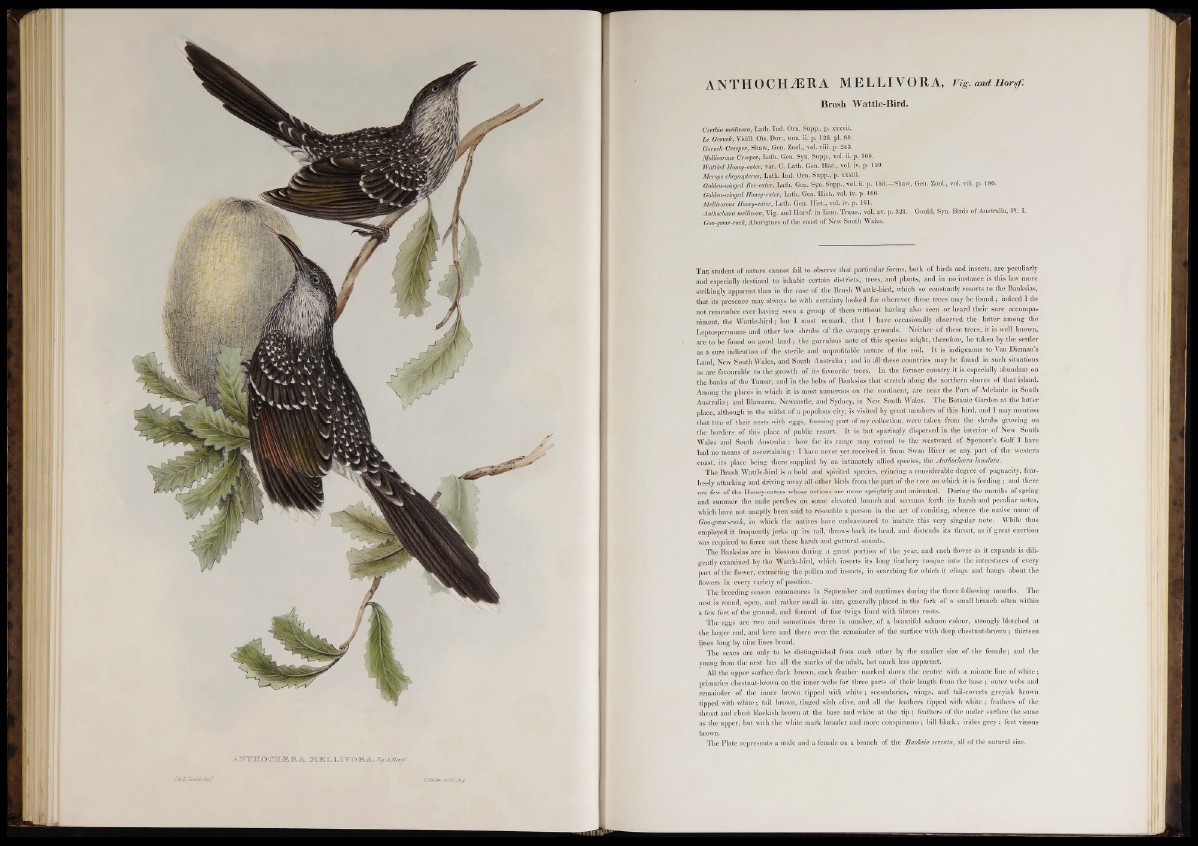
AN'TCfflLOCM^B.A. MEILOVOIRA. Tfy.&Jfortf
J&E.GotUd, ¿Ul?
ANTHOCH^ERA MELLIVORA, Vig. and Horsf.
Brush Wattle-Bird.
Certhia mellivora, Lath. Ind. Orn. Supp., p. xxxvii.
Le Goruch, Yieill. Ois. Dor., tom. ii. pv 126. pi. 88.
Goruck Creeper, Shaw, Gen. Zool., vol. viii. p. 243.
MelUvorous Creeper, Lath. Gen. Syn. Supp., voL ii. p. 166.
Wattled Honey-eater, var. 0 . Lath. Gen. Hist., vol. iv. p. 159.
Merops chrysopterus, Lath. Ind. Orn. Supp., p. xxxiii.
Golden-winged Bee-eater, Lath. Gen. Syn. Supp., vol. ii. p. 153.—Shaw, Gen. Zool., vol. viii. p. 180.
Golden-winged Honey-eater, Lath. Gen. Hist., vol. iv. p. 160.
Mellivorous Honey-eater, Lath. Gen. Hist., vol. iv. p. 161.
Anthochsra mellivora, Vig. and Horsf. in Linn. Trans., vol. xv. p. 321. Gould, Syn. Birds of Australia, Pt. I.
Goo-gwar-ruck, Aborigines of the coast of New South Wales.
T h e student of nature cannot fail to observe that particular forms, both of birds and insects, are peculiarly
and especially destined to inhabit certain districts, trees, and plants, and in no instance is this law more
strikingly apparent than in the case of the Brush Wattle-bird, which so constantly resorts to the Banksias,
that its presence may always be with certainty looked for wherever these trees may be found; indeed I do
not remember ever having seen a group of them without having also seen or heard their sure accompaniment,
the Wattle-bird; but I must remark, that I have occasionally observed the latter among the
Leptospermums and other low shrubs of the swampy grounds. Neither o f these trees, it is well known,
are to be found on good land; the garrulous note of this species might, therefore, be taken by the settler
as a sure indication of the sterile and unprofitable nature of the soil. It is indigenous to Van Dieman’s
Land, New South Wales, and South Australia; and in all these countries may be found in such situations
as are favourable to the growth of its favourite trees. In the former country it is especially abundant on
the banks o f the Tamar, and in the belts of Banksias that stretch along the northern shores of that island.
Among the places in which it is most numerous on the continent, are near the Port of Adelaide in South
Australia; and Illawarra, Newcastle, and Sydney, in New South Wales. The Botanic Garden at the latter
place, although in the midst o f a populous city, is visited by great numbers of this bird, and I may mention
that two o f their nests with eggs, forming part o f my collection, were taken from the shrubs growing on
the borders of this place of public resort. It is but sparingly dispersed in the interior of New South
Wales and South Australia: how far its range may extend to the westward of Spencer’s Gulf I have
had no means of ascertaining.: I have never yet received it from Swan River or any part o f the western
Coast, its place being there supplied by an intimately allied species, the AnthochcBra lunulata.
The Brush Wattle-bird is a bold and spirited species, evincing a considerable degree o f pugnacity, fearlessly
attacking and driving away all other birds from the part o f the tree on which it is feeding; and there
are few of the Honey-eaters whose actions are more sprightly and animated. During the months of spring
and summer the male perches on some elevated branch and screams forth its harsh and peculiar notes,
which have not unaptly been said to resemble a person in the act of vomiting, whence the native name of
Goo-gtoar-ruck, in which the natives have endeavoured to imitate this very singular note. While thus
employed it frequently jerks up its tail, throws back its head, and distends its throat, as if great exertion
was required to force out these harsh and guttural sounds.
The Banksias are in blossom during a great portion o f the year, and each flower as it expands is diligently
examined by the Wattle-bird, which inserts its long feathex-y tongue into the interstices of every
part of the flower, extracting the pollen and insects, in searching for which it clings and hangs about the
flowers in every variety of position.
The breeding season commences in September and continues during the three following months. The
nest is round, open, and rather small in size, generally placed in the fork of a small branch often within
a few feet of the ground, and formed o f fine twigs lined with fibrous roots.
The eggs are two and sometimes three in number, of a beautiful salmon colour, strongly blotched at
the larger end, and here and there over the remainder o f the surface with deep chestnut-brown ; thirteen
lines long by nine lines broad.
The sexes are only to be distinguished from each other by the smaller size of the female; and the
young from the nest has all the marks of the adult, but much less apparent.
All the upper surface dark brown, each feather marked down the centre with a minute line of white;
primaries chestnut-brown on the inner webs for three parts of their length from the base ; outer webs and
remainder of the inner brown tipped with white; secondaries, wings, and tail-coverts greyish brown
tipped with white; tail brown, tinged with olive, and all the feathers tipped with white ; feathers of the
throat and chest blackish brown at the base and white at the tip ; feathers of the under surface the same
as the upper, but with the white mark broader and more conspicuous; bill black; irides grey; feet vinous
brown.
The Plate represents a male and a female on a branch o f the Banksia serrata, all of the natural size.